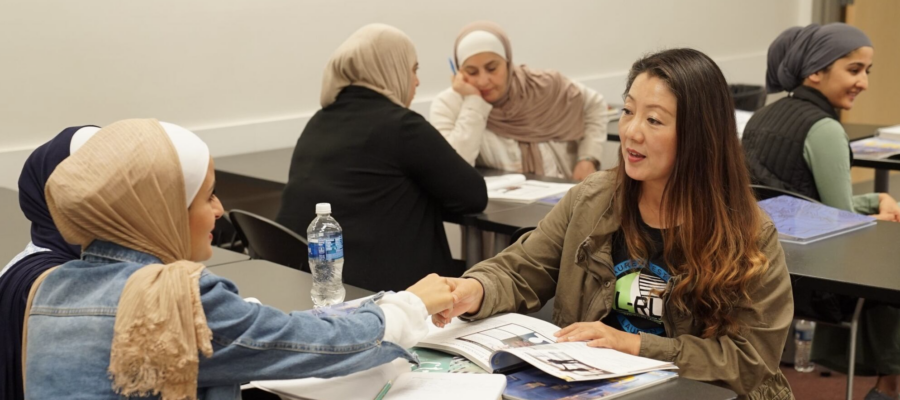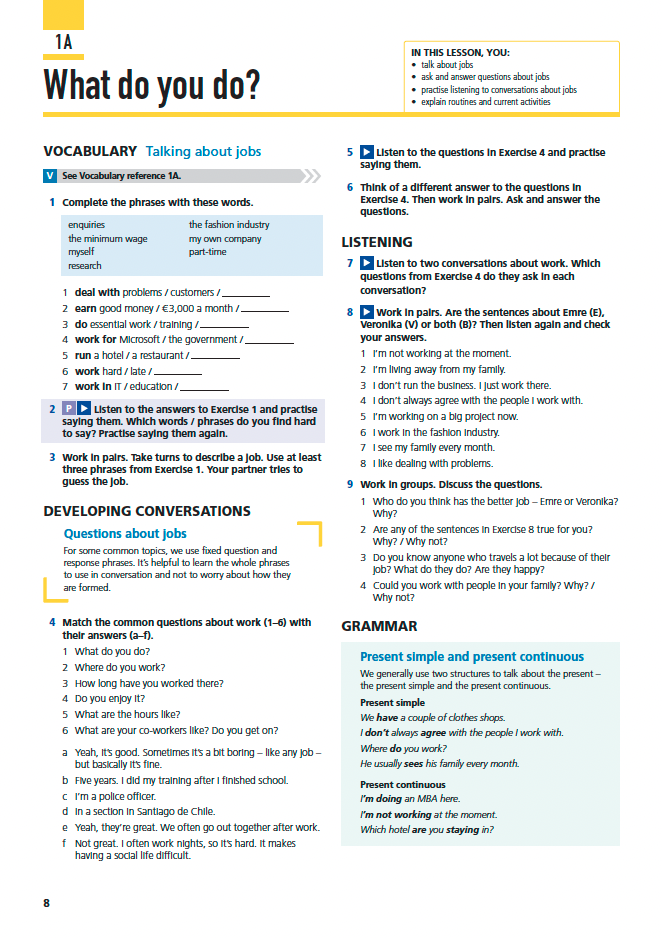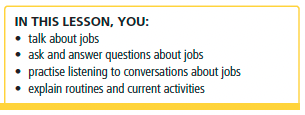Traditionally, ELT listening lessons often focused on micro-skills like using context and general knowledge to get the gist. More recently, there has been a reconsideration of listening and how we might improve it, based on four main processes. These can be described as:
- knowing language
- recognizing sounds and words
- developing automatic recall of meaning
- building understanding of text
In this post, we define these four processes and explain how to use them in the classroom to help students achieve better listening outcomes.
To learn more about this topic, watch our webinar with Hugh Dellar, Practical Tips for Improving Listening Outcomes in the English Classroom!
Knowing language
It’s a simple truth, but better listening starts with knowing more of the words in a text. If you only know 30% of the words you hear, you’ll understand less than someone who knows 80% of them.
But what language should we teach first? Start by thinking about the language students will need most for everyday conversations.
The language choices in the Outcomes series are determined by clear speaking goals based on common conversations students want to have. We consider the words and grammar students will need, using sources such as the English Vocabulary Profile and word frequency for leveling.
At the Beginner level, Outcomes also presents a variety of forms through teaching simple chunks and patterns such as What are you doing [time word]? / I’m going to [place / action]; What did you do [time]? / I went to [place]; my best friend / the best place, etc. This allows students to recognize forms earlier – and to take part in more common conversations.
Recognizing sounds and words
Even in slow-ish speech, words come at us in a continuous stream of sound. It’s like reading the previous sentence like this: eveninslowishspeechwordscomeatusinacontinuousstreamofsound
English learners can struggle to break these streams down into words. Students may have learned single words in one form — end, do, leave or read a book — but what they hear is intheend, whatareyoudoingnow, ileftit, haveyoureadit. Familiar words also change their ‘shape’ as sounds get dropped or changed. Students may hear ‘even in’ as ‘evening’ or ‘the words we hear’ as ‘the worse we’re’. In addition, speakers often add in sounds and words like just, basically, sort of, I mean, er and um, all of which can distract listeners if they have only heard scripted speech without these features.
Obviously, if you don’t know a word or phrase, ‘guessing’ its meaning is difficult as it’s often not clear where its boundaries are. For example, ‘they mended the car’ could be heard as ‘the men did the car’.
You can help students recognize words in context in several ways. Firstly, present key words on their own and in common chunks, so students hear the difference between, say, ‘end’ and ‘at the end of the road’ or ‘sort out’ and ‘I’ll sort it out’. In Outcomes, we work on key words and chunks in pronunciation sections. Additionally, our online pronunciation tasks provide a systemic review of individual sounds in key words to help learners distinguish between words like ‘bat’ and ‘bet’ and ‘bet’ and ‘vet’.
In each Outcomes unit, we also include a fast speech activity that helps students hear language. These activities take 5-8 extracts from a larger listening text and focus on word recognition issues. Here are some sample activities:
| • recognize negatives (isn’t, can’t, don’t, not very, etc.) |
| • recognize the preposition(s) in chunks (on top of, interested in) |
| • recognize a chunk and predict the next word (I’m from; have you been to) |
| • decide how many words are in a chunk |
| • write down chunks where a sound may disappear or appear (nextime / gowoutonight) |
| • recognize and write down a new word to look up or ask about |
| • recognize common words used in all extracts (just / really) |
Teachers could also take key words from previous lessons and dictate them in chunks or sentences, using similar pronunciation and fast speech tasks.
Developing automatic recall of meaning
Even when listeners correctly break down what they hear, they still have to recall the meaning of those words. This can be a slow process and in the time it takes students to recall, they may miss the next bits of text. If students are constructing the meaning of whole texts, the process of recognizing words and recalling meaning has to be automatic, meaning that they can process chunks of language rather than individual words.
Automaticity develops through repetition within and across lessons. Learners need to hear words in context repeatedly through pronunciation, through language recycled in listenings, through fast speech activities and maybe through the teacher doing drills and dictations. However, teachers might also consider having students listen to audio texts multiple times.
Most courses provide two listening tasks – a general gist task and a more detailed listen – and Outcomes is no exception. We have many exam-like tasks as well as the micro-listening fast speech activity. Teachers can play an important role by asking students for answers – rather than giving them – and when students answer, don’t say if they’re right or wrong. Instead, ask them to explain why they chose those answers and what exact words they heard. Then re-play the extract to confirm. If there is still uncertainty, you might also add an extra listening task such as:
- listen one more time and write any new words you hear
- listen one more time and write a question you’d like to ask
- listen one more time and raise your hand when you hear one of these words (use a selection from the text)
Building understanding of text
Once listeners have processed the sounds they hear, divided them into words and chunks and recalled meanings, they need to link what they have understood so far with what they hear next. They then build an understanding of the whole ‘story’ by drawing on context and world knowledge. Learners can do this even if they have only understood fragments and it’s fine to encourage them to use this strategy, but it’s important to understand that at the lowest levels especially, learners are essentially guessing – and they’ll only be able to get better at guessing by knowing and recognizing more language.
Comprehension tasks often follow an exam format used in common tests like PET or IELTS. These require students to show understanding of a whole text, but you can develop students’ ability in this area by consistently asking students to discuss answers in pairs first. You can also work on this by forgoing a focused task and instead simply telling students to take notes on what they hear and discuss what they understood. They then listen again and add to / change their notes before discussing – and maybe listening a third time. You could then use the comprehension tasks in the book as a test.
Listening beyond the classroom
In the end, the classroom can only offer a limited amount of practice in developing listening. Learners make the most progress when they are hearing and using language outside of the classroom. Online teaching platforms like Spark can provide students with additional audio and video material, but you might also encourage students to do things like listen to music, podcasts, or videos – whatever interests them.
The limits of classroom time also highlights the need to enable common conversations from the beginning. If students are taught a phrase like ‘What are you doing now?’ early on, they’ll be better able to take part in these conversations outside class, meaning conversations continue longer. This leads to hearing more language – and improving listening.
We hope this post gave you an understanding of the main processes for improving listening outcomes and how to incorporate these strategies into your English classes. Let us know what you think in the comments section below!




